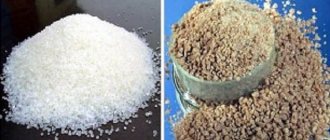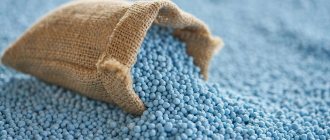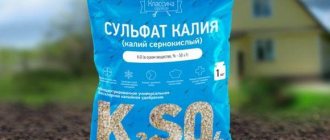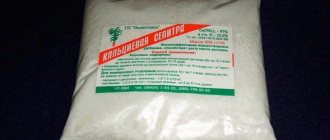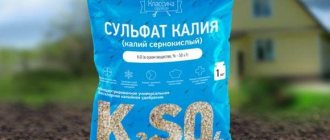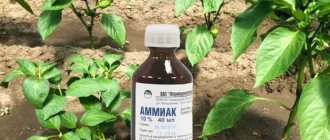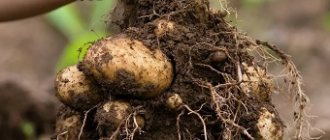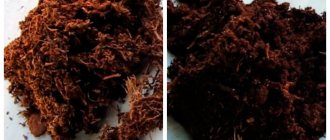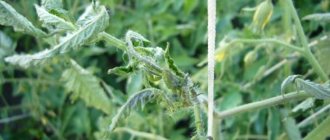One of the best fertilizers for feeding tomatoes is Potassium Monophosphate. It contains 52% phosphorus, which is very necessary for plants to form flower buds. They begin to develop at the seedling stage. Therefore, tomatoes are fed with Monophosphate several times during cultivation. When and how to use fertilizer, read our article.
By the way! Potassium Monophosphate is perfect for feeding tomato seedlings against pulling and for rooting. The recipe is below.
Potassium monophosphate for tomato seedlings
This is one of the most concentrated phosphorus-potassium fertilizers. Contains 52% phosphorus and 34% potassium, it is completely soluble in water. Promotes strengthening of the root system, growth of buds and flowers in plants.
Tomatoes need potassium more than any other nutrient. The use of this fertilizer strengthens the skin, improves the taste and color of the fruit. Phosphorus promotes the development of the root system of plants. Check out the article - 12 ways to increase your tomato yield.
How to dilute potassium monophosphate for tomato seedlings
The drug is used in solutions that should be prepared in small quantities. Since it quickly loses its properties in liquid form. Dissolve the product in both warm and cold water.
To feed seedlings, use 7-10 g of the drug per 10 liters of water. The first feeding is at the moment of formation of 2-3 true leaves. Use 3-5 liters of fertilizer per 1 sq. meter.
Feeding tomatoes after picking with potassium monophosphate
2 weeks after picking the seedlings, a second feeding is carried out. With the formation of 5-6 leaves - the third, the composition of the drug is the same, quantity - 5-10 liters per 1 sq. meter. Water over damp soil.
What do tomatoes like?
Potassium fertilizers for tomatoes help accelerate metabolism, which has a good effect on fruit set and ripening. Feeding helps the plant survive spring temperature fluctuations and protects it from pathogens. Transplantation and rooting occurs faster. At the same time, other substances, nitrogen and phosphorus, must also be present in sufficient quantities.
Video: Expert advice on fertilizing tomatoes, including potash
The tomato bush feels good when the nutrition is balanced. To do this, you should follow the sequence of feeding:
- In the spring, before planting seedlings, you need to fertilize the soil with nitrogen so that the plants can gain green mass and be ready to set fruit.
- Towards the end of flowering, the most important moment comes - fertilizing with potassium mixtures. If time is lost, some part of the plants may shed flowers or ovaries. At this moment, you should watch the tomatoes especially carefully in order to notice the lack of substances in time. Gardeners usually water their plots every evening. There is time to take a closer look at the foliage - if it begins to change color, then urgent action must be taken. One foliar feeding is enough for the plant to come to life.
- In the fall, after harvesting, you need to restore the soil by digging it up with phosphorus and potassium. Fertilizers will dissolve over the winter, and in the spring it will be easy for plants to absorb nutrients.
There are different types of potash fertilizers, but not all of them are suitable for the type of soil. Knowing the characteristics of each type of mineral fertilizer, taking into account the composition of the soil - its pH, you can choose the optimal nutrition for plants (more on this in the section on types of potash fertilizers).
Feeding adult tomatoes
After planting the plants in a permanent place, apply potassium monophosphate to tomatoes 2 times with an interval of 2-3 weeks.
Root and foliar feeding of tomatoes is carried out in the open ground and in greenhouses.
How to dilute potassium monophosphate for tomatoes
The preparation of the solution depends on the form of the substance that is used.
When diluting the powder, you need to use distilled or boiled water. The granules can be diluted in any water.
How to water tomatoes at the root
For root feeding, use a solution of 15 g of the drug and 10 liters of water. In the greenhouse, treat the plants when the first ovaries appear. Use one bucket of liquid for 4 tomato bushes.
Useful articles:
- Application of Nitrophoska in the garden
- How to feed cucumbers for a good harvest
- How to use Potassium Sulfate as a fertilizer
Spraying tomatoes with potassium monophosphate
Apply foliar feeding with a 0.2% solution, i.e. Dissolve 2 g of the substance in 10 liters of water. Spray plants between main crop treatments.
Use 4-6 liters of fertilizer per 1 square. meter, for young bushes 2-3 liters for this area. Fertilizing stimulates flowering and the appearance of ovaries in plants. At the time of flowering, spray the tomatoes with a concentrated fertilizer solution. Dilute the product in a ratio of 1:10.
Compatibility with other types of fertilizers
Potassium monophosphate is a complex fertilizer. The two main components for tomatoes are balanced and work for the harvest. Agrochemists are constantly trying to improve the composition, digestibility, and solubility of fertilizers, but, unfortunately, chemical compounds are quite capricious.
Note! Potassium monophosphate can be combined with other fertilizers.
It has long been proven that alternating fertilizing with organic and mineral fertilizers gives an excellent effect. There is no point in adding anything else to the monophosphate. It would be more correct to fertilize with organic matter, and after 10 days with monophosphate, then again with organic matter.
It has been proven that frequent, but not concentrated fertilizing provides a higher yield addition than rare and concentrated fertilizing. Minerals remain in the soil and are absorbed by plants.
Advantages and disadvantages of feeding tomatoes
In their reviews, gardeners note a number of advantages of Potassium Monophosphate:
- the product is well absorbed by plants;
- increases productivity and product quality by increasing sugars and vitamins;
- improves frost resistance of crops and their resistance to diseases;
- the use of fertilizer will not harm the environment;
- good compatibility with other drugs;
- low impact on changes in soil acidity;
- increasing the shelf life of tomatoes as a result of using the product;
- Flowers develop additional stems with peduncles.
Disadvantages include:
- it is inadmissible to soak plant seeds in a solution, which will slow down the development of the crop;
- You should not prepare a mixture of fertilizer with nitrogen, calcium and magnesium for fertilizing;
- the product is hygroscopic and loses its properties when wet;
- Weeds are very fond of the drug;
- Fertilizer quickly disintegrates in the soil, so apply it only in solution.
In what cases is it used?
Monopotassium is considered an effective fertilizer. The main advantages of the product include the following:
- absence of harmful components and heavy metals in the composition;
- improving the taste of fruits;
- protection of plants from fungal microorganisms and powdery mildew;
- protection of seedlings from temperature fluctuations;
- maintaining optimal humidity parameters in the greenhouse;
- increasing the flowering period of domestic flowers;
- no risk of soil acidification.
The substance makes seedlings more resistant to adverse weather conditions and provides protection against pathologies and parasites. The drug is available in the form of powder or granules. Thanks to this, it is quickly absorbed by the soil and absorbed by plant roots.
The drug combines well with pesticides. Thanks to this, it allows for complex processing of crops in open ground. Experts recommend combining pesticides with fertilizer in one container.
See also
Advantages and disadvantages of rye as green manure, when to sow and how long it takes for it to sproutRead
Fertilizer also has a good effect on soil microorganisms. By creating comfortable conditions, it is possible to more actively structure the soil. This is especially important for greenhouse soil, which often dries out. The use of the substance helps reduce the need for irrigation.
How to replace Potassium Monophosphate for tomatoes
This fertilizer differs from others in that the phosphorus contained in it is easily absorbed by garden crops. Other medications must be added a year in advance for this element to take effect.
Analog of Potassium Monophosphate – Pekacid
You can replace potassium monophosphate with superphosphate and potassium nitrate. But the only substance with a similar composition is Pekacid. But this fertilizer is more expensive than Potassium Monophosphate.
Composition of Pekacid:
- phosphorus – 60%;
- potassium – 20%
Operating principle
The drug has many advantages. With its regular use, the following positive effects have been noted:
- at the budding stage, the number of flowers and fruits begins to increase;
- improvement of marketability and taste criteria of tomatoes;
- strengthening immunity against a large number of pathogens;
- increased resistance to frost;
- improved resistance to pests;
- increase in the volume of vegetative mass.
Phosphorus is important for photosynthesis and the growth of vegetative mass. If there is a lack of an element in the soil, the following is disrupted:
- bloom;
- set of green mass volume;
- fruit formation.
If you fertilize correctly, tomatoes will ripen earlier and the shoots will look green and fresh. Phosphorus is important for the formation of inflorescences and ovaries. If there is enough element in the soil, the roots will be well branched.
Potassium monophosphate has good solubility. Tomatoes quickly absorb fertilizer.
Reviews of potassium monophosphate
Vera, Nizhny Novgorod
I have been using monopotassium phosphate for tomatoes for many years and have not noticed any changes in the soil. I have a lot of flowers in the garden and I always feed them with this product. They grow bushy, bloom profusely and for a long time. One day I didn’t read the instructions and scattered the granules dry, and didn’t get the effect. I advise you not to forget to read the instructions for use.
Olga, Noginsk
I use a product to feed seedlings. The roots become strong by the time of planting, and the plants take root well. To avoid surprises, I do not mix monophosphate with nitrogen, although there are no contraindications. Every 2 weeks I water the plants with fertilizer because it is harmless. And its composition is optimal for plants.
Precautionary measures
Monopotassium phosphate is a fertilizer and chemical product. The NFPA standard designated the substance with the numbers 1;0;0. This means the following:
- health hazard - 1. Exposure may cause irritation with minimal residual damage;
- flammability - 0. Non-flammable substance;
- instability - 0. Stable even when exposed to an open flame;
In any case, when working with mineral fertilizers, labor protection rules and precautions remain in force. They are based on scientific data and clinical studies and should not be ignored.
When planning to prepare a solution and feed tomatoes, you need to consider the following:
- the working solution should not come into contact with exposed parts of the body. To avoid this, you need to use work clothes that cover all open parts;
- while working, you must not smoke, eat or drink water;
- Avoid working with mineral fertilizers if you feel unwell or have had an infectious disease;
- purchased fertilizer must be stored in a labeled bag and out of reach of children and pets;
- The fertilizer should not be used by people who have diseases of the skin, respiratory tract or gastrointestinal tract;
- At the end of the work, the container and all exposed parts of the body should be washed with soap and water, and the clothes should be washed.
Many vegetable growers neglect these rules. Indeed, the solution of potassium monophosphate is not concentrated and not caustic, but you need to be careful.
Indications for use
Potassium monophosphate or potassium salt of orthophosphoric acid is added if symptoms of potassium or phosphorus deficiency appear:
- abundant flowering of fruit trees and berry bushes, but after it there are small fruits and no fruit at all;
- leaves are wrinkled, similar to corrugated paper, twisted into a tube;
- yellowing and then browning of the leaves, their downward tilt, the dying off of the foliage along with the cuttings;
- thinning of shoots;
- growth arrest at the peak of the growing season.
Monopotassium phosphate is useful in early spring, especially if frosts have persisted or the weather has been rainy for a long time. It performs well on peat-bog, sandy loam sod-podzolic, sandy, gray forest soils, and southern chernozems.
The need for phosphorus and potassium also increases if the soil contains large amounts of lime.
Moreover, the combination of phosphorus and potassium in the mixture does not change the pH of the soil, but only has a beneficial effect on its biochemical composition.
